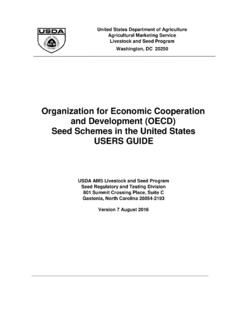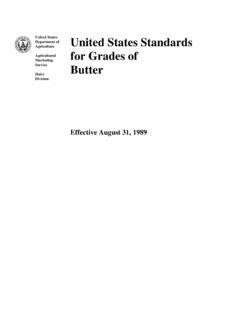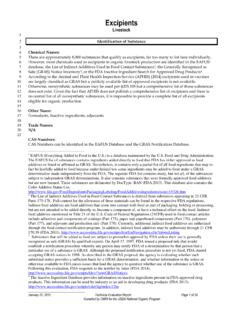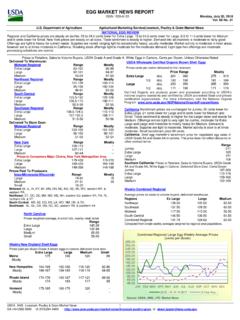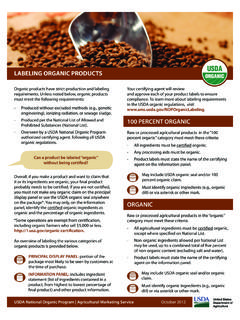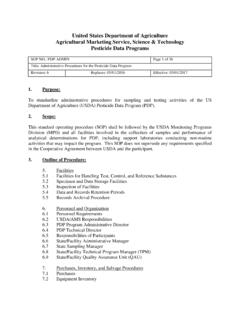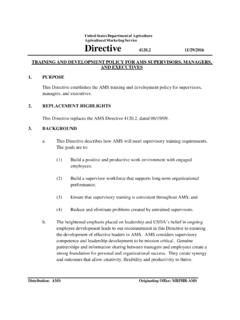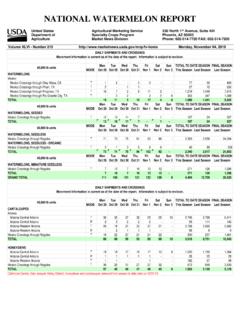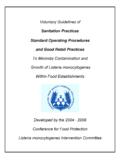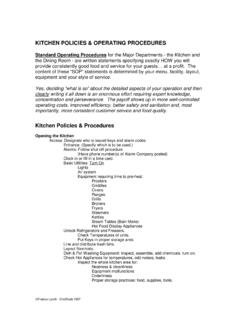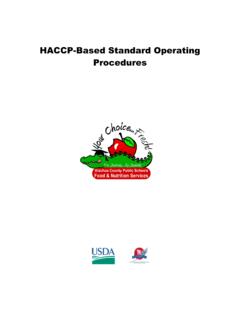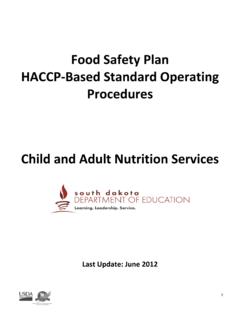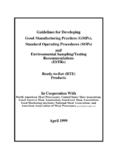Transcription of Regulatory Harmonized Food Safety Standard
1 Marketing and Regulatory Programs Agricultural Marketing Service Specialty Crops Program Specialty Crops Inspection Division Produce GAPs Harmonized food Safety Standard January 5, 2018 For Official Government Use Only. The Produce GAPs Harmonized food Safety Standard is based on the Produce GAPs Harmonized Combined Harmonized food Safety Standard Version , developed by the GAPs Harmonization Initiative. Use of the Harmonized food Safety Standard has been granted by the Secretariat of the GAPs Harmonization Initiative through a non-exclusive copyright license. Non-Discrimination Policy: In accordance with Federal civil rights law and Department of Agriculture (USDA) civil rights regulations and policies, the USDA, its Agencies, offices, and employees, and institutions participating in or administering USDA programs are prohibited from discriminating based on race, color, national origin, religion, sex, gender identity (including gender expression), sexual orientation, disability, age, marital status, family/parental status, income derived from a public assistance program, political beliefs, or reprisal or retaliation for prior civil rights activity, in any program or activity conducted or funded by USDA (not all bases apply to all programs).
2 Remedies and complaint filing deadlines vary by program or incident. Persons with disabilities who require alternative means of communication for program information ( , Braille, large print, audiotape, American Sign Language, etc.) should contact the responsible Agency or USDA's TARGET Center at (202) 720-2600 (voice and TTY) or contact USDA through the Federal Relay Service at (800) 877-8339. Additionally, program information may be made available in languages other than English. To file a program discrimination complaint, complete the USDA Program Discrimination Complaint Form, AD-3027, found online at How to File a Program Discrimination Complaint and at any USDA office or write a letter addressed to USDA and provide in the letter all of the information requested in the form. To request a copy of the complaint form, call (866) 632-9992. Submit your completed form or letter to USDA by: (1) mail: Department of Agriculture, Office of the Assistant Secretary for Civil Rights, 1400 Independence Avenue, SW, Washington, 20250-9410; (2) fax: (202) 690-7442; or (3) email: USDA is an equal opportunity provider, employer, and lender.
3 Ii Produce GAPs Harmonized food Safety Standard Section Page No. Introduction .. 1 Scopes of Audit .. 1 Standard Layout .. 1 General Questions (G) .. 2 G-1: Management Responsibility .. 2 G-2: food Safety Plan or Risk Assessment .. 3 G-3: Documentation & Recordkeeping .. 4 G-4: Worker Education and Training .. 5 G-5: Sampling and Testing .. 7 G-6: 8 G-7: Recall Program .. 9 G-8: Corrective Actions and food Safety Incidents .. 9 G-9: Self-Audits .. 10 G-10: Worker Health/Hygiene and Toilet/Handwashing Facilities .. 10 G-11: Waste 18 Field operations and Harvesting (F).. 19 F-1: Field History and Assessment .. 19 F-2: Agricultural Chemicals /Plant Protection Products .. 21 F-3: Water System Description .. 24 F-4: Water System Risk Assessment .. 25 F-5: Water Management Plan .. 26 F-6: Animal Control .. 29 F-7: Soil Amendments .. 31 F-8: Vehicles, Equipment, Tools and Utensils .. 32 Harvesting .. 35 F-9: Preharvest 35 F-10: Water/Ice Used in the Harvesting and Postharvest operations .
4 35 iii F-11: Containers, Bins and Packaging Materials .. 38 F-12: Field Packaging and Handling .. 39 F-13: Postharvest Handling and Storage (Field Prior to Storage or Packinghouse) .. 42 F-14: Equipment Sanitation and Maintenance .. 43 Post-Harvest operations (P) .. 45 P-1: Produce Sourcing .. 45 P-2: Agricultural Chemicals .. 46 P-3: Facility .. 48 P-4: Pest and Animal Control .. 51 P-5: Equipment, Tools and Utensils .. 52 P-6: Maintenance and Sanitation .. 54 P-7: Post-Harvest Water/Ice .. 59 P-8: Containers, Bins and Packaging .. 64 P-9: Storage .. 67 P-10: Transportation (Packinghouse to Customer) .. 70 Logo Use (L) .. 72 L-1: food Safety Plan or Quality Manual .. 72 L-2: Traceability and Recall Programs .. 72 L-3: Approved Suppliers .. 73 L-4: GAP & GHP Logo Approved Use .. 74 Produce GAPs Harmonized food Safety Standard Version (2018) 1 of 74 Introduction The Produce GAPs Harmonized food Safety Standard is based on the Harmonization Initiative Harmonized food Safety standards located at: This Standard has been reorganized to align with the Produce GAPs Harmonized food Safety Standard USDA Checklist.
5 Scopes of Audit The Produce GAPs Harmonized food Safety Audit is comprised of four scopes: General Questions, Field operations and Harvesting, Post-Harvest operations , and Logo Use. The General Questions scope is required to be completed for every audit. One or both of the Field operations and Harvesting and/or Post Harvest Scopes will be completed based on the type of operation being audited. The Logo Use scope must be completed for any Operation who intends to use the USDA GAP & GHP Logo on packaging or promotional materials. Standard Layout The Standard has specified columns for the Requirement (Req. # & Requirement Description), Documentation (DOC), Mandatory (MAN), Procedure, Verification and Corrective Action. Requirement: Is a specification of the conditions expected to be met by the auditee. DOC: The auditing standards require verification of written policies, procedures and plans (WP); records (R); and risk assessment (A).
6 To help auditors identify where documents (DOC) are required, the Standard includes a DOC column that designates the type of documentation to verify WP, R, A, or a combination of these document types. Written Policies, procedures , and/or Plans (WP) - A policy is high-level guidance that describes general goals and acceptable procedures for an organization. A procedure is a specified way to carry out an activity or process. A plan outlines actions that will be taken by an organization to mitigate risk. Policies, procedures and plans may be communicated orally or in writing. They are only required to be written if a WP is indicated in the DOC column in this Standard . Records (R)- A record is a document stating results achieved or providing evidence of activities performed. Records may include checklists, service records, billing forms, and water tests. Risk Assessment (A)- A risk assessment is a process to identify potential hazards on a farm and/or packinghouse as well as the likelihood the hazards will impact the Safety of fruits and vegetables.
7 Risk assessments should be documented in the manner which best represents the operation and the type of risk assessment required. This may include a combination of WP and/or R documents. MAN: A in this column indicates a requirement that is mandatory and must either be assessed as compliant (C) or not applicable (N/A) in order to meet USDA Acceptance Criteria. Procedure: Is a more detailed explanation of the conditions expected to be met by the auditee in order to meet the requirement. Verification: Are the conditions verified by the auditor to determine if the auditee meets the requirement. Corrective Actions: Are actions to be taken by the auditee if it is found that they do not meet the requirement. Produce GAPs Harmonized food Safety Standard Version (2018) 2 of 74 General Questions (G) Req. # Requirement DOC MAN Procedure Verification Corrective Action G-1: Management Responsibility A food Safety policy shall be in place.
8 WP A written policy shall outline a commitment to food Safety , in general terms, how it is implemented and how it is communicated to employees, and be signed by Senior Management. The auditor observes the food Safety policy, observes that it is signed by Senior Management, and observes that it has been communicated to all employees in a manner that can be understood. The Operation creates or revises the policy, or its communication to employees, to be in compliance. Management has designated individual(s) with roles and responsibilities for food Safety functions. WP The food Safety Plan shall designate who has the responsibility and authority for food Safety , including a provision for the absence of key personnel. Twenty-four hour contact information shall be available for these individuals in case of food Safety emergencies. These roles and responsibilities shall be communicated within the organization. Auditor observes that the food Safety Plan has identified individual(s) for key food Safety activities.
9 Auditor verifies that procedures include provisions for when the identified individual is not present. Operation identifies individual(s) for key food Safety activities in the food Safety Plan. Operation identifies actions to be taken when the identified individual(s) are not present. There is a disciplinary policy for food Safety violations. There shall be a policy that establishes corrective actions for personnel who violate established food Safety policies or procedures . Auditor observes the policy and checks for examples of enforcement. The Operation creates or revises the policy, or its communication to employees, to be in compliance. Produce GAPs Harmonized food Safety Standard Version (2018) 3 of 74 Req. # Requirement DOC MAN Procedure Verification Corrective Action G-2: food Safety Plan or Risk Assessment There shall be a written food Safety Plan. The plan shall cover the Operation. The Operation and products covered shall be defined.
10 WP The food Safety Plan shall identify all locations of Operation covered by the plan and shall identify physical, chemical, and biological hazards reasonably likely to occur and hazard control procedures , including monitoring, verification and recordkeeping, for all provisions covered by this audit. Auditor shall observe the food Safety Plan and verify that the plan has considered potential biological, chemical and physical hazards and has identified preventive controls for hazards that may reasonably affect food Safety . Operation develops or completes a food Safety Plan for all locations of Operation. The food Safety Plan shall be reviewed at least annually. R Operation shall be responsible for reviewing their food Safety Plan at least annually, documenting the review procedure and revising the plan as necessary. Updated or revised on date shall be indicated. Auditor reviews last food Safety Plan review. Operation reviews food Safety Plan and documents review.

